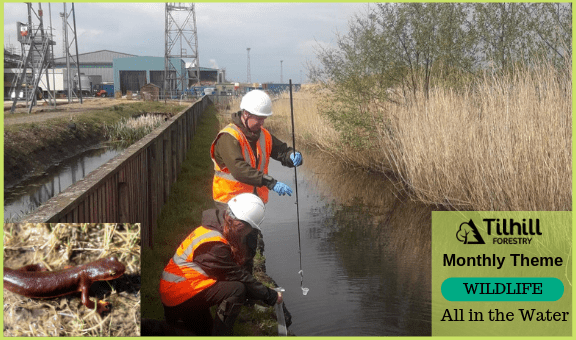This website uses cookies so that we can provide you with the best user experience possible. Cookie information is stored in your browser and performs functions such as recognising you when you return to our website and helping our team to understand which sections of the website you find most interesting and useful.
Tilhill Forestry’s parent company BSW had a requirement to find out exactly what neighbours were sharing their Carlisle mill site.
With a nature reserve nearby and several slow-flowing ditches, siltation ponds, and sumps on site, it was considered likely that Great Crested Newts could be enjoying the sawmill’s wetland habitats for breeding. They are a European Protected Species (EPS) and so they, their eggs, breeding sites and resting places are protected to the highest level by law. On this basis, responsible site management dictated a check to see if they were resident at the mill site.
Sarah Oakley, one of Tilhill Forestry’s in-house ecologists, and Reuben Singleton from Tweed Ecology Ltd, undertook the survey using a rather new approach – eDNA testing, the basis of which revolves around sampling for Great Crested Newt DNA being present in the water.
Water samples were therefore taken from five waterbodies which allowed full coverage of potential GCN breeding habitat across the site. Twenty samples were collected from evenly spaced locations around each waterbody using a ladle taped to the end of a fishing rod for ease of access, and mixed together in a plastic bag. Once mixed, 15 ml samples were pipetted from the bag into six sterile tubes containing ethanol to preserve the eDNA.
Sarah Oakley, Tilhill Forestry Ecologist said:
“I had known about GCN eDNA sampling being used in the New Forest, but had never had the opportunity to implement it myself. This site’s requirements, and the support of licenced expert Reuben Singleton, made it an ideal candidate. Reuben’s experience of this sampling method brought his bespoke modification of a fishing rod to attach the ladle to – minimising the risk of contamination between waterbodies, but possibly causing a few raised eyebrows as we tramped across the site with a fishing rod in tow.”
The avoidance of cross-contamination of samples is vital, so sterile gloves were changed between sample collection from the pond and pipetting into the sterile sub-sample tubes, and again between different ponds. The plastic ladle was also changed between ponds.
The samples were then stored in a refrigerator before being sent off to the lab to check for the presence of Great Crested Newt DNA.
For a complete and thorough investigation, physical searches for amphibians (and reptiles) were made of the suitable refuges on the site (under old pallets and sheets etc) but none were found. As it turned out, there was no evidence of the Great Crested Newt being present at the Carlisle mill site.
However, the neighbours turned out to be present in a very different guise, namely a pair of Oystercatcher that appeared to be nesting on top of a flat-roofed building towards the south of the site.
We look forward to congratulating them on their expanding family and hope they prove to be sociable neighbours.




